wheelbase FORD E SERIES 2021 Owners Manual
[x] Cancel search | Manufacturer: FORD, Model Year: 2021, Model line: E SERIES, Model: FORD E SERIES 2021Pages: 301, PDF Size: 3.05 MB
Page 129 of 301
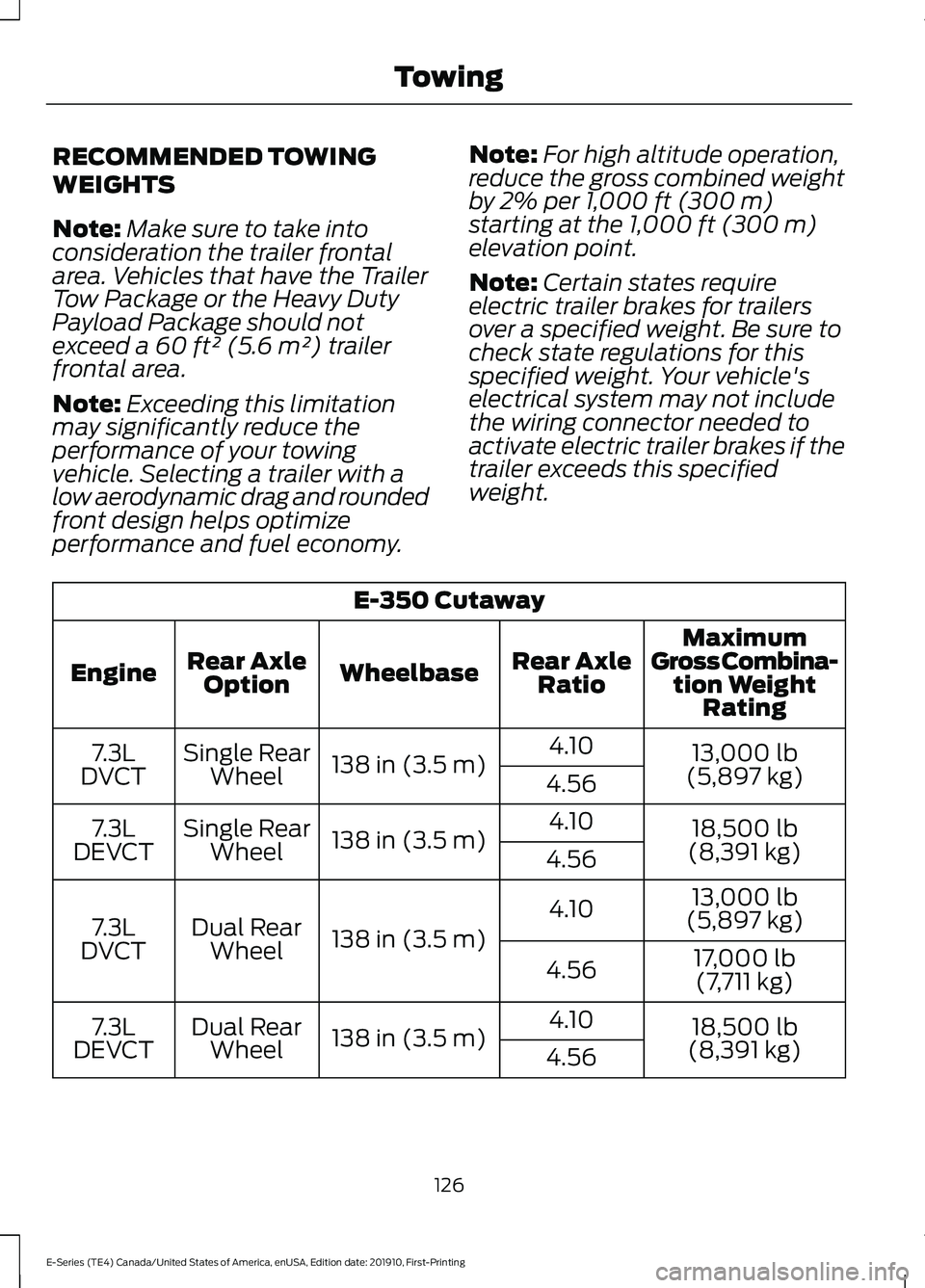
RECOMMENDED TOWING
WEIGHTS
Note:
Make sure to take into
consideration the trailer frontal
area. Vehicles that have the Trailer
Tow Package or the Heavy Duty
Payload Package should not
exceed a 60 ft² (5.6 m²) trailer
frontal area.
Note: Exceeding this limitation
may significantly reduce the
performance of your towing
vehicle. Selecting a trailer with a
low aerodynamic drag and rounded
front design helps optimize
performance and fuel economy. Note:
For high altitude operation,
reduce the gross combined weight
by 2% per 1,000 ft (300 m)
starting at the 1,000 ft (300 m)
elevation point.
Note: Certain states require
electric trailer brakes for trailers
over a specified weight. Be sure to
check state regulations for this
specified weight. Your vehicle's
electrical system may not include
the wiring connector needed to
activate electric trailer brakes if the
trailer exceeds this specified
weight. E-350 Cutaway
Maximum
Gross Combina- tion Weight Rating
Rear Axle
Ratio
Wheelbase
Rear Axle
Option
Engine
13,000 lb
(5,897 kg)
4.10
138 in (3.5 m)
Single Rear
Wheel
7.3L
DVCT 4.56
18,500 lb
(8,391 kg)
4.10
138 in (3.5 m)
Single Rear
Wheel
7.3L
DEVCT 4.56
13,000 lb
(5,897 kg)
4.10
138 in (3.5 m)
Dual Rear
Wheel
7.3L
DVCT 17,000 lb
(7,711 kg)
4.56
18,500 lb
(8,391 kg)
4.10
138 in (3.5 m)
Dual Rear
Wheel
7.3L
DEVCT 4.56
126
E-Series (TE4) Canada/United States of America, enUSA, Edition date: 201910, First-Printing Towing
Page 130 of 301
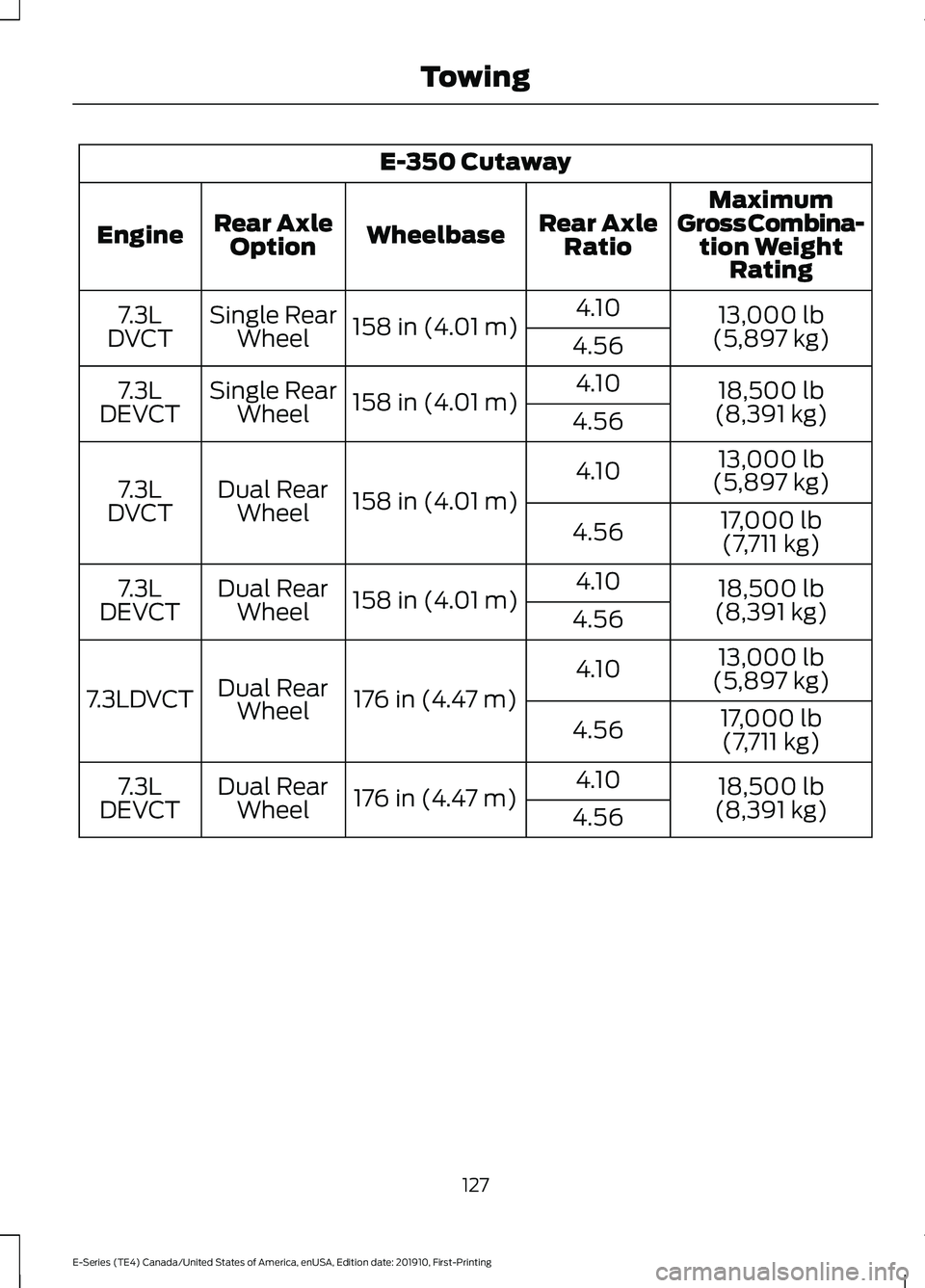
E-350 Cutaway
Maximum
Gross Combina- tion Weight Rating
Rear Axle
Ratio
Wheelbase
Rear Axle
Option
Engine
13,000 lb
(5,897 kg)
4.10
158 in (4.01 m)
Single Rear
Wheel
7.3L
DVCT 4.56
18,500 lb
(8,391 kg)
4.10
158 in (4.01 m)
Single Rear
Wheel
7.3L
DEVCT 4.56
13,000 lb
(5,897 kg)
4.10
158 in (4.01 m)
Dual Rear
Wheel
7.3L
DVCT 17,000 lb
(7,711 kg)
4.56
18,500 lb
(8,391 kg)
4.10
158 in (4.01 m)
Dual Rear
Wheel
7.3L
DEVCT 4.56
13,000 lb
(5,897 kg)
4.10
176 in (4.47 m)
Dual Rear
Wheel
7.3LDVCT
17,000 lb
(7,711 kg)
4.56
18,500 lb
(8,391 kg)
4.10
176 in (4.47 m)
Dual Rear
Wheel
7.3L
DEVCT 4.56
127
E-Series (TE4) Canada/United States of America, enUSA, Edition date: 201910, First-Printing Towing
Page 131 of 301
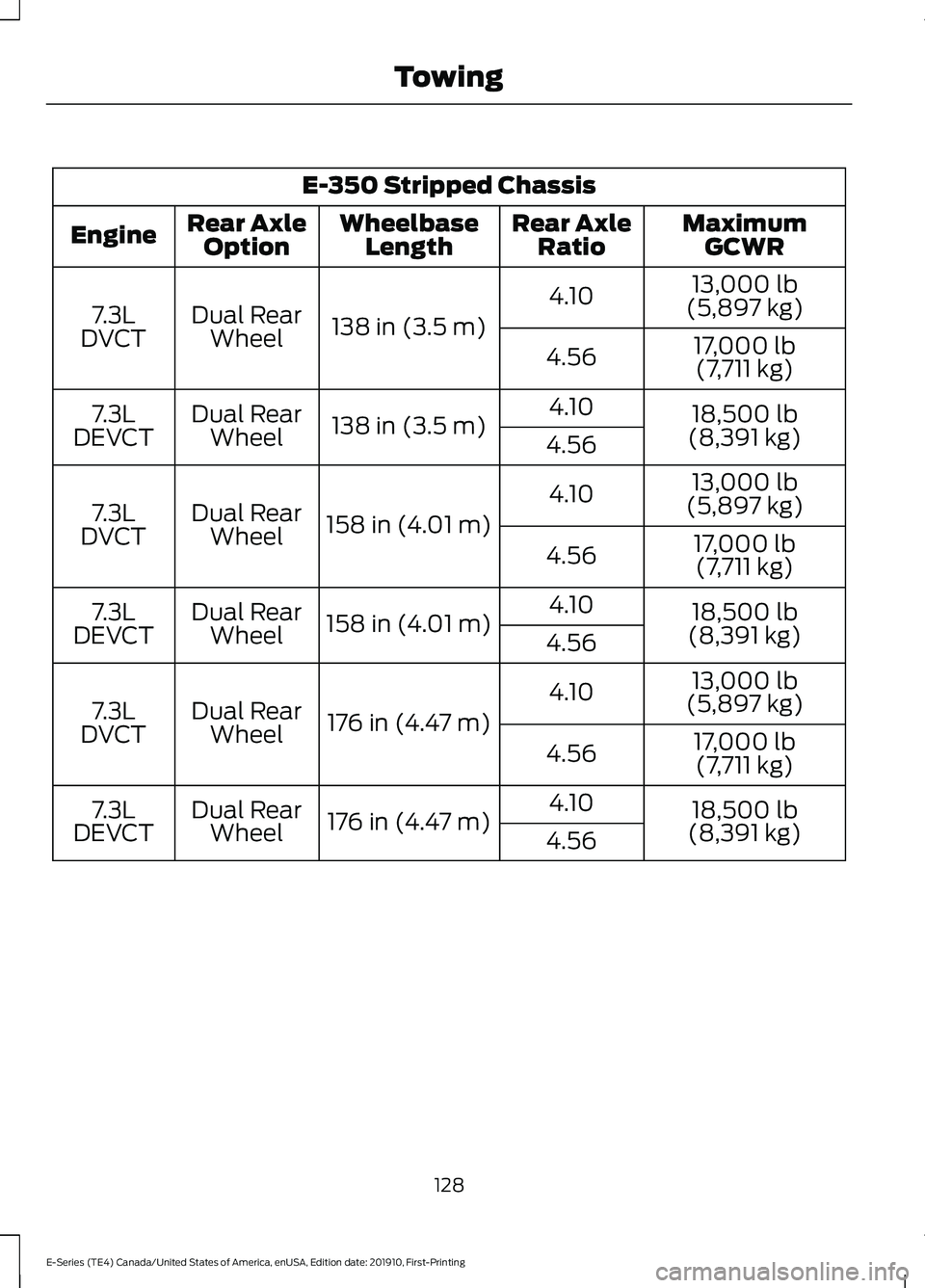
E-350 Stripped Chassis
MaximumGCWR
Rear Axle
Ratio
Wheelbase
Length
Rear Axle
Option
Engine
13,000 lb
(5,897 kg)
4.10
138 in (3.5 m)
Dual Rear
Wheel
7.3L
DVCT 17,000 lb
(7,711 kg)
4.56
18,500 lb
(8,391 kg)
4.10
138 in (3.5 m)
Dual Rear
Wheel
7.3L
DEVCT 4.56
13,000 lb
(5,897 kg)
4.10
158 in (4.01 m)
Dual Rear
Wheel
7.3L
DVCT 17,000 lb
(7,711 kg)
4.56
18,500 lb
(8,391 kg)
4.10
158 in (4.01 m)
Dual Rear
Wheel
7.3L
DEVCT 4.56
13,000 lb
(5,897 kg)
4.10
176 in (4.47 m)
Dual Rear
Wheel
7.3L
DVCT 17,000 lb
(7,711 kg)
4.56
18,500 lb
(8,391 kg)
4.10
176 in (4.47 m)
Dual Rear
Wheel
7.3L
DEVCT 4.56
128
E-Series (TE4) Canada/United States of America, enUSA, Edition date: 201910, First-Printing Towing
Page 132 of 301
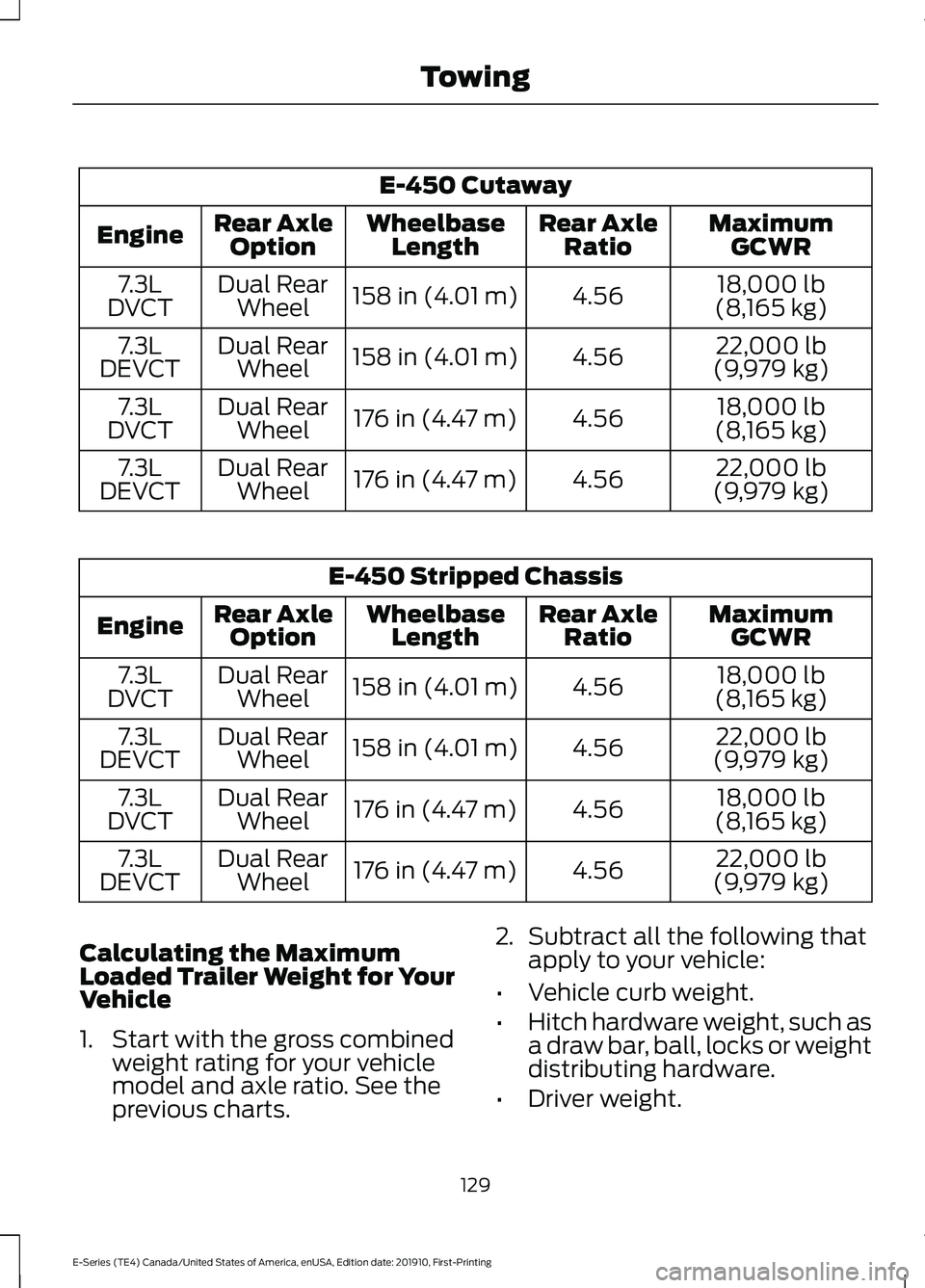
E-450 Cutaway
MaximumGCWR
Rear Axle
Ratio
Wheelbase
Length
Rear Axle
Option
Engine
18,000 lb
(8,165 kg)
4.56
158 in (4.01 m)
Dual Rear
Wheel
7.3L
DVCT
22,000 lb
(9,979 kg)
4.56
158 in (4.01 m)
Dual Rear
Wheel
7.3L
DEVCT
18,000 lb
(8,165 kg)
4.56
176 in (4.47 m)
Dual Rear
Wheel
7.3L
DVCT
22,000 lb
(9,979 kg)
4.56
176 in (4.47 m)
Dual Rear
Wheel
7.3L
DEVCT E-450 Stripped Chassis
MaximumGCWR
Rear Axle
Ratio
Wheelbase
Length
Rear Axle
Option
Engine
18,000 lb
(8,165 kg)
4.56
158 in (4.01 m)
Dual Rear
Wheel
7.3L
DVCT
22,000 lb
(9,979 kg)
4.56
158 in (4.01 m)
Dual Rear
Wheel
7.3L
DEVCT
18,000 lb
(8,165 kg)
4.56
176 in (4.47 m)
Dual Rear
Wheel
7.3L
DVCT
22,000 lb
(9,979 kg)
4.56
176 in (4.47 m)
Dual Rear
Wheel
7.3L
DEVCT
Calculating the Maximum
Loaded Trailer Weight for Your
Vehicle
1. Start with the gross combined weight rating for your vehicle
model and axle ratio. See the
previous charts. 2.
Subtract all the following that
apply to your vehicle:
• Vehicle curb weight.
• Hitch hardware weight, such as
a draw bar, ball, locks or weight
distributing hardware.
• Driver weight.
129
E-Series (TE4) Canada/United States of America, enUSA, Edition date: 201910, First-Printing Towing
Page 192 of 301
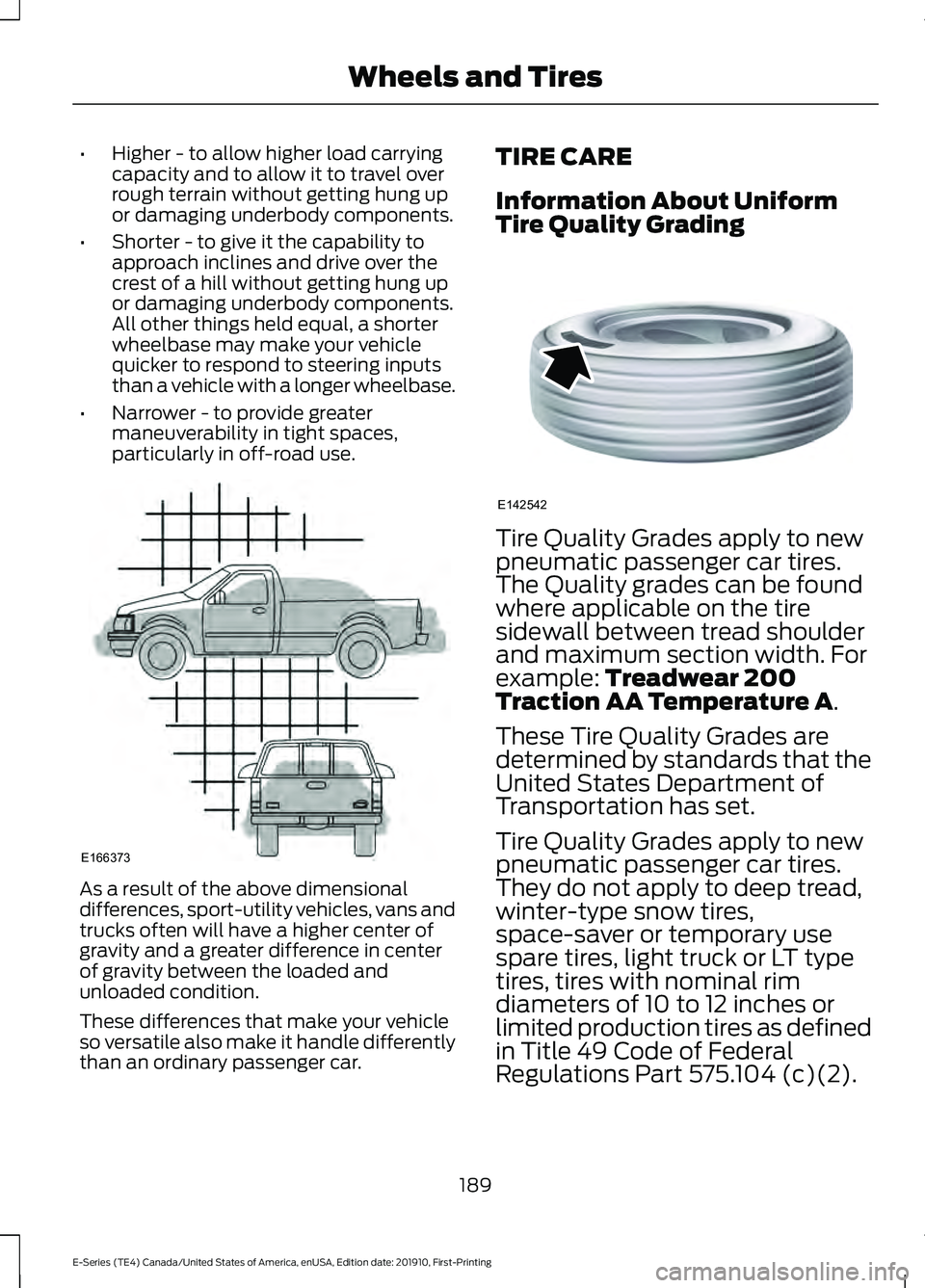
•
Higher - to allow higher load carrying
capacity and to allow it to travel over
rough terrain without getting hung up
or damaging underbody components.
• Shorter - to give it the capability to
approach inclines and drive over the
crest of a hill without getting hung up
or damaging underbody components.
All other things held equal, a shorter
wheelbase may make your vehicle
quicker to respond to steering inputs
than a vehicle with a longer wheelbase.
• Narrower - to provide greater
maneuverability in tight spaces,
particularly in off-road use. As a result of the above dimensional
differences, sport-utility vehicles, vans and
trucks often will have a higher center of
gravity and a greater difference in center
of gravity between the loaded and
unloaded condition.
These differences that make your vehicle
so versatile also make it handle differently
than an ordinary passenger car. TIRE CARE
Information About Uniform
Tire Quality Grading
Tire Quality Grades apply to new
pneumatic passenger car tires.
The Quality grades can be found
where applicable on the tire
sidewall between tread shoulder
and maximum section width. For
example: Treadwear 200
Traction AA Temperature A.
These Tire Quality Grades are
determined by standards that the
United States Department of
Transportation has set.
Tire Quality Grades apply to new
pneumatic passenger car tires.
They do not apply to deep tread,
winter-type snow tires,
space-saver or temporary use
spare tires, light truck or LT type
tires, tires with nominal rim
diameters of 10 to 12 inches or
limited production tires as defined
in Title 49 Code of Federal
Regulations Part 575.104 (c)(2).
189
E-Series (TE4) Canada/United States of America, enUSA, Edition date: 201910, First-Printing Wheels and TiresE166373 E142542